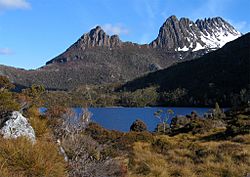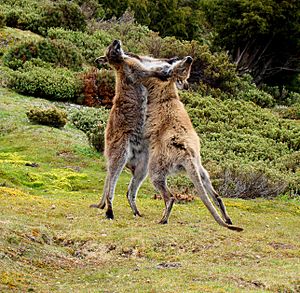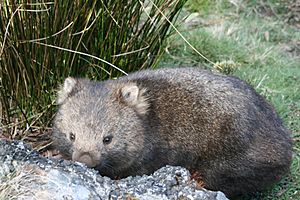Cradle Mountain-Lake St Clair National Park facts for kids
Quick facts for kids Cradle Mountain-Lake St Clair National Park * |
|
|---|---|
 Cradle Mountain and Dove Lake, Tasmanian Wilderness |
|
| Country | |
| Type | Mixed |
| Criteria | iii, iv, vi, vii, viii, ix, x |
| Reference | 507 |
| Region ** | Asia-Pacific |
| Inscription history | |
| Inscription | 1982 (6th Session) |
| Extensions | 1989 |
|
|
The Cradle Mountain-Lake St Clair National Park is a super special place in Tasmania, Australia. It's part of the huge Tasmanian Wilderness World Heritage Site. This park is really big! It has beautiful lakes, cool rainforests, and open areas called alpine heathland.
You'll find Cradle Mountain here, which is a pointy mountain made of a rock called dolerite. Long, long ago, about 10,000 years back, Indigenous Australians lived in this area. That was during the last ice age! Tasmania's tallest mountain, Mt. Ossa, is also in the park. It stands 1,617 metres (5,305 ft) above sea level.
This amazing area was first protected in May 1922 as a scenic reserve. It became a National Park in 1972. Today, the park covers a huge area of 397,840 acres (161,000 ha). There's a famous walking trail called the Overland Track. It's 73 kilometres (45 mi) long and goes between Cradle Mountain and Lake St. Clair.
Contents
Park Fees and How They Help
Since 2005, if you want to walk the Overland Track during busy times, you need to book and pay a fee. This money helps keep the park wonderful for everyone. It pays for park rangers, who look after the area. It also helps maintain the walking tracks and build new facilities. Plus, it helps pay for helicopters to remove waste from the toilets in the park's huts.
New Ideas for the Park
The Tasmanian Government has been looking at allowing some new developments in national parks. One idea is an 'eco-friendly' resort at Pumphouse Point, near Lake St Clair. This resort would be designed to be good for the environment.
Amazing Plants and Animals

Cradle Mountain-Lake St Clair National Park is home to many unique plants and animals found only in Tasmania. A lot of the park's alpine plants (plants that grow in high, cold places) are found nowhere else. Also, most of the rainforest plants found in Tasmania's alpine areas grow right here. The park's alpine plants are very diverse. Luckily, they have mostly avoided the big forest fires that have affected nearby areas.
You can spot many cool animals in the park, like pademelons, Bennett's wallabies, quolls, Tasmanian devils, echidnas, platypuses, wombats, possums, ravens, and currawongs.
Birds of the Park
This park is known as an Important Bird Area (IBA). This means it's a really important place for birds. It provides a home for 11 types of birds that are only found in Tasmania. You might also see flame and pink robins, and the striated fieldwren here. The park is a great protected area in north-central Tasmania for these special birds.
The Hidden World of Fungi
Fungi are also a big part of the park's amazing nature. The park has many different kinds of fungi. They do important jobs for the environment. Most fungi are helpful, not harmful. Even fungi that might seem like parasites actually help keep the ecosystem healthy by controlling how things work.
Other Cool Places Nearby
The Tasmanian Wilderness World Heritage Area includes other National Parks and reserves, such as:
- Franklin-Gordon Wild Rivers National Park
- Hartz Mountains National Park
- Mole Creek Karst National Park
- Southwest National Park
- Walls of Jerusalem National Park
- Central Plateau Conservation Area
- Devils Gullet State Reserve
- South East Mutton Bird Islet
See also
In Spanish: Parque nacional Cradle Mountain-Lake St. Clair para niños



